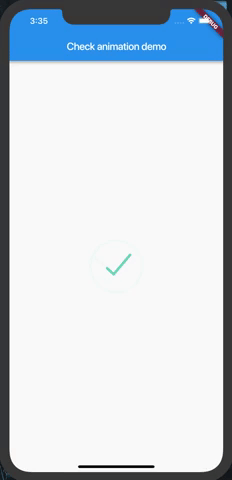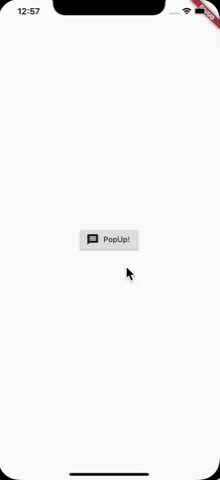Flutter custom animated dialog
I tried to do the animation shown in your gif. Gonna post the code to help people who want it, its not perfect so if anyone wants to help improving it go for it.
How it looks:

Code:
import 'package:flutter/material.dart';
import 'package:angles/angles.dart';
import 'dart:math';
import 'dart:core';
class CheckAnimation extends StatefulWidget {
final double size;
final VoidCallback onComplete;
CheckAnimation({this.size, this.onComplete});
@override
_CheckAnimationState createState() => _CheckAnimationState();
}
class _CheckAnimationState extends State<CheckAnimation>
with SingleTickerProviderStateMixin {
AnimationController _controller;
Animation<double> curve;
@override
void initState() {
// TODO: implement initState
super.initState();
_controller =
AnimationController(duration: Duration(seconds: 2), vsync: this);
curve = CurvedAnimation(parent: _controller, curve: Curves.bounceInOut);
_controller.addListener(() {
setState(() {});
if(_controller.status == AnimationStatus.completed && widget.onComplete != null){
widget.onComplete();
}
});
_controller.forward();
}
@override
Widget build(BuildContext context) {
return Container(
height: widget.size ?? 100,
width: widget.size ?? 100,
color: Colors.transparent,
child: CustomPaint(
painter: CheckPainter(value: curve.value),
),
);
}
@override
void dispose() {
// TODO: implement dispose
_controller.dispose();
super.dispose();
}
}
class CheckPainter extends CustomPainter {
Paint _paint;
double value;
double _length;
double _offset;
double _secondOffset;
double _startingAngle;
CheckPainter({this.value}) {
_paint = Paint()
..color = Colors.greenAccent
..strokeWidth = 5.0
..strokeCap = StrokeCap.round
..style = PaintingStyle.stroke;
assert(value != null);
_length = 60;
_offset = 0;
_startingAngle = 205;
}
@override
void paint(Canvas canvas, Size size) {
// Background canvas
var rect = Offset(0, 0) & size;
_paint.color = Colors.greenAccent.withOpacity(.05);
double line1x1 = size.width / 2 +
size.width * cos(Angle.fromDegrees(_startingAngle).radians) * .5;
double line1y1 = size.height / 2 +
size.height * sin(Angle.fromDegrees(_startingAngle).radians) * .5;
double line1x2 = size.width * .45;
double line1y2 = size.height * .65;
double line2x1 =
size.width / 2 + size.width * cos(Angle.fromDegrees(320).radians) * .35;
double line2y1 = size.height / 2 +
size.height * sin(Angle.fromDegrees(320).radians) * .35;
canvas.drawArc(rect, Angle.fromDegrees(_startingAngle).radians,
Angle.fromDegrees(360).radians, false, _paint);
canvas.drawLine(Offset(line1x1, line1y1), Offset(line1x2, line1y2), _paint);
canvas.drawLine(Offset(line2x1, line2y1), Offset(line1x2, line1y2), _paint);
// animation painter
double circleValue, checkValue;
if (value < .5) {
checkValue = 0;
circleValue = value / .5;
} else {
checkValue = (value - .5) / .5;
circleValue = 1;
}
_paint.color = const Color(0xff72d0c3);
double firstAngle = _startingAngle + 360 * circleValue;
canvas.drawArc(
rect,
Angle.fromDegrees(firstAngle).radians,
Angle.fromDegrees(
getSecondAngle(firstAngle, _length, _startingAngle + 360))
.radians,
false,
_paint);
double line1Value = 0, line2Value = 0;
if (circleValue >= 1) {
if (checkValue < .5) {
line2Value = 0;
line1Value = checkValue / .5;
} else {
line2Value = (checkValue - .5) / .5;
line1Value = 1;
}
}
double auxLine1x1 = (line1x2 - line1x1) * getMin(line1Value, .8);
double auxLine1y1 =
(((auxLine1x1) - line1x1) / (line1x2 - line1x1)) * (line1y2 - line1y1) +
line1y1;
if (_offset < 60) {
auxLine1x1 = line1x1;
auxLine1y1 = line1y1;
}
double auxLine1x2 = auxLine1x1 + _offset / 2;
double auxLine1y2 =
(((auxLine1x1 + _offset / 2) - line1x1) / (line1x2 - line1x1)) *
(line1y2 - line1y1) +
line1y1;
if (checkIfPointHasCrossedLine(Offset(line1x2, line1y2),
Offset(line2x1, line2y1), Offset(auxLine1x2, auxLine1y2))) {
auxLine1x2 = line1x2;
auxLine1y2 = line1y2;
}
if (_offset > 0) {
canvas.drawLine(Offset(auxLine1x1, auxLine1y1),
Offset(auxLine1x2, auxLine1y2), _paint);
}
// SECOND LINE
double auxLine2x1 = (line2x1 - line1x2) * line2Value;
double auxLine2y1 =
((((line2x1 - line1x2) * line2Value) - line1x2) / (line2x1 - line1x2)) *
(line2y1 - line1y2) +
line1y2;
if (checkIfPointHasCrossedLine(Offset(line1x1, line1y1),
Offset(line1x2, line1y2), Offset(auxLine2x1, auxLine2y1))) {
auxLine2x1 = line1x2;
auxLine2y1 = line1y2;
}
if (line2Value > 0) {
canvas.drawLine(
Offset(auxLine2x1, auxLine2y1),
Offset(
(line2x1 - line1x2) * line2Value + _offset * .75,
((((line2x1 - line1x2) * line2Value + _offset * .75) - line1x2) /
(line2x1 - line1x2)) *
(line2y1 - line1y2) +
line1y2),
_paint);
}
}
double getMax(double x, double y) {
return (x > y) ? x : y;
}
double getMin(double x, double y) {
return (x > y) ? y : x;
}
bool checkIfPointHasCrossedLine(Offset a, Offset b, Offset point) {
return ((b.dx - a.dx) * (point.dy - a.dy) -
(b.dy - a.dy) * (point.dx - a.dx)) >
0;
}
double getSecondAngle(double angle, double plus, double max) {
if (angle + plus > max) {
_offset = angle + plus - max;
return max - angle;
} else {
_offset = 0;
return plus;
}
}
@override
bool shouldRepaint(CheckPainter old) {
return old.value != value;
}
}
I used angles package
Just use 'showGeneralDialog()' No need use extra lib or widget.
You can get more animatated dialog reference from This Link
void _openCustomDialog() {
showGeneralDialog(barrierColor: Colors.black.withOpacity(0.5),
transitionBuilder: (context, a1, a2, widget) {
return Transform.scale(
scale: a1.value,
child: Opacity(
opacity: a1.value,
child: AlertDialog(
shape: OutlineInputBorder(
borderRadius: BorderRadius.circular(16.0)),
title: Text('Hello!!'),
content: Text('How are you?'),
),
),
);
},
transitionDuration: Duration(milliseconds: 200),
barrierDismissible: true,
barrierLabel: '',
context: context,
pageBuilder: (context, animation1, animation2) {});
}

To create dialog boxes you can use the Overlay or Dialog classes. If you want to add animations like in the given framework you can use the AnimationController like in the following example. The CurvedAnimation class is used to create the bouncing effect on the animation.
Update: In general it is better to show dialogs with the showDialog function, because the closing and gesture are handled by Flutter. I have updated the example, it is now running with showDialog and you are able to close the dialog by tapping on the background.

You can copy & paste the following code into a new project and adjust it. It is runnable on it's own.
import 'package:flutter/material.dart';
void main() => runApp(new MyApp());
class MyApp extends StatelessWidget {
@override
Widget build(BuildContext context) {
return MaterialApp(title: 'Flutter Demo', theme: ThemeData(), home: Page());
}
}
class Page extends StatelessWidget {
@override
Widget build(BuildContext context) {
return Scaffold(
body: Center(
child: RaisedButton.icon(
onPressed: () {
showDialog(
context: context,
builder: (_) => FunkyOverlay(),
);
},
icon: Icon(Icons.message),
label: Text("PopUp!")),
),
);
}
}
class FunkyOverlay extends StatefulWidget {
@override
State<StatefulWidget> createState() => FunkyOverlayState();
}
class FunkyOverlayState extends State<FunkyOverlay>
with SingleTickerProviderStateMixin {
AnimationController controller;
Animation<double> scaleAnimation;
@override
void initState() {
super.initState();
controller =
AnimationController(vsync: this, duration: Duration(milliseconds: 450));
scaleAnimation =
CurvedAnimation(parent: controller, curve: Curves.elasticInOut);
controller.addListener(() {
setState(() {});
});
controller.forward();
}
@override
Widget build(BuildContext context) {
return Center(
child: Material(
color: Colors.transparent,
child: ScaleTransition(
scale: scaleAnimation,
child: Container(
decoration: ShapeDecoration(
color: Colors.white,
shape: RoundedRectangleBorder(
borderRadius: BorderRadius.circular(15.0))),
child: Padding(
padding: const EdgeInsets.all(50.0),
child: Text("Well hello there!"),
),
),
),
),
);
}
}